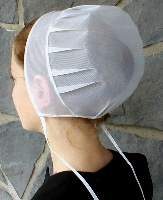 <PERSONAL INFO – CAN BE SKIPPED>Ok, I'm back. The last six months were extremely exhausting. In order to avoid one extra year of my masters studies, I had to take four classes in five months. This is comparable to a full time student's plan. I also had to teach a new course on the Corinthian letters (but NT is not my area of expertise!) and to go on missions trip to Bosnia and on business trip to Missouri. My life was adventurous. And extremely stressful. My wife Anička [Anitschka] was lion-hearted as usual, but still I hope that we'll have a substantial rest this summer.
<PERSONAL INFO – CAN BE SKIPPED>Ok, I'm back. The last six months were extremely exhausting. In order to avoid one extra year of my masters studies, I had to take four classes in five months. This is comparable to a full time student's plan. I also had to teach a new course on the Corinthian letters (but NT is not my area of expertise!) and to go on missions trip to Bosnia and on business trip to Missouri. My life was adventurous. And extremely stressful. My wife Anička [Anitschka] was lion-hearted as usual, but still I hope that we'll have a substantial rest this summer.
My second son was born in the beginning of this month. We named him Saul. Saul Buban. He's big, beautiful, and a very good boy. He hates to be alone and to be hungry, which makes us both happy (because we like to be with him) and even more busy. Our older son is doing well too.</PERSONAL INFO>
So much for personal info. I have three papers from the last semester to edit and publish on Academia.edu. I'll start with the one that I did for NT exegesis class. It's aim is to expose the logic of 1 Corinthians 11:2–16. These are the most salient points of my exegetical proposal.
- 1 Cor 11:2–16 is a coherent argument. It shouldn't be dealt with as a set of separate issues, as is the case in some commentaries. We need to unveil the logic of this passage as a whole, not to tinker with the logic of individual statements and/or lexical background of individual words.
- Paul uses here imageries of creation, procreation, and new creation. And in verse 11:3, he merges them. In other words, Paul merges sex with theology and presents it in a single bundle. This is not the only case of such practice. See also Paul's theological argument in 1 Cor 6:15–18.
- Verse 3 is something like a mindmap. Let me quote myself:
(1) When Paul says that “the head of the woman is man,” he alludes both to creation, because man was woman’s source, and to procreation, because woman is man’s glory. (2) When he says that “the head of every man is Christ,” he alludes to the new creation of a Christian person, whose source is always Christ. (3) And when he adds that “the head of Christ is God,” he alludes to the creation and the new creation of mankind again, because he puts Christ in between of the created order and the new creation.
My argument is largely depending on Troy Martin's proposal for 1 Cor 11:13–15. Martin argues that Paul's thinking was influenced by Hippocratic medicine, which understood woman's hair as counterpart of man's testicles. It's purported function was to create suction in woman's body, which would draw in man's reproductive fluids. Now if hair was an erotic organ, it's display in public worship was obviously a breach of etiquette, to say the least.
I take Martin's argument one step further by exploring it's implication for the passage as a whole. I propose that 1 Corinthians 11:3 is not a blunt statement of hierarchical created order, as some complementarians and (functional) subordinationists do hold. It rather is a mindmap, where imageries of creation, procreation, and new creation are deliberately merged together in order to highlight the main points of subsequent argument. I also contend that the word “head” (kephale) in 1 Cor 11:3 does not contain hierarchical, but rather purely relational connotations. My reasons for this decision are both lexical (kephale doesn't mean “authority over” in the Septuagint) and exegetical (it makes much better sense not to translate it as “authority over”).
Postscript. One of the issues with the passage is the translation of ἀντὶ περιβολαίου in v. 15. Here are the possibilities that I'm aware of.
- According to classical translation, ἀντὶ περιβολαίου means “instead of covering.” This obviously shatters the point of immediate context.
- Troy Martin says that περιβολαίον is a colloquial euphemism meaning “testicles.” Hair is thus given to woman instead of testicles.
- I propose that “ἀντὶ” could have a purely spatial meaning here. Hair would thus be given “behind” or “against” head covering. In other words, hair must be always opposite to (ἀντὶ) the covering in a very spatial sense. That simply means “behind it.” Does it make sense to you? Do you know an experienced Greek scholar who might be able to answer this proposal of mine?
You'll find the paper here. Keep tuned! Two OT papers are coming.
Have you inquired as to what Dr. Martin thinks of your proposal?
No, I haven’t. I don’t know him in person and I had to move on to other fields very soon after I finished this paper. I wonder what would he say though.
Have you by chance read the response from Goodacre, and then the response to the response?